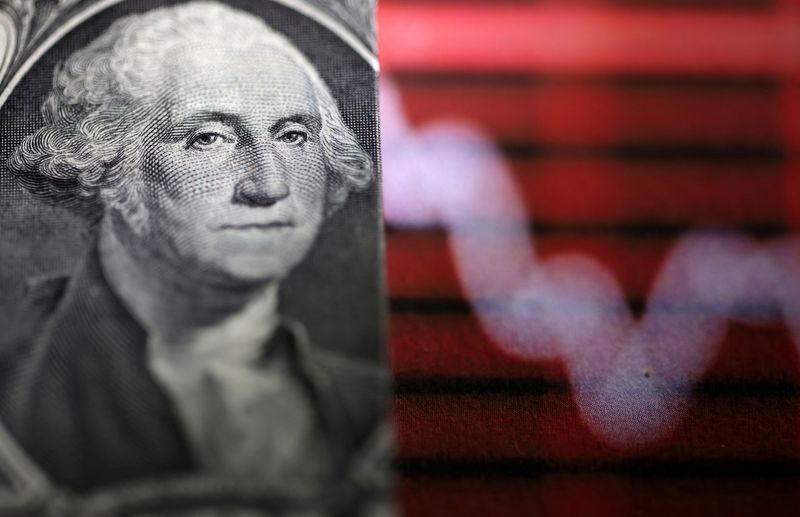By Davide Barbuscia and David Randall
NEW YORK (Reuters) - A closely watched part of the U.S. Treasury yield curve inverted on Monday for the first time since April following hotter-than-anticipated inflation data last week.
As the U.S. Federal Reserve attempts to bring inflation down from 40-year highs, banks have ramped up projections of interest rate hikes, and some shorter-dated bond yields surged higher than longer term ones.
Here is a quick primer on what a steep, flat or inverted yield curve means and how it has predicted recession, and what it might be signaling now.
WHAT SHOULD THE CURVE LOOK LIKE?
The U.S. Treasury finances federal government budget obligations by issuing various forms of debt. The $23 trillion https://fred.stlouisfed.org/series/MVMTD027MNFRBDAL Treasury market includes bills that mature in one month to one year, two- to 10-year notes, and 20- and 30-year bonds.
The yield curve, which plots the return on all Treasury securities, typically slopes upward as the payout increases with the duration. Yields move inversely to prices.
A steepening curve typically signals expectations for stronger economic activity, higher inflation, and higher interest rates. A flattening curve can mean investors expect near-term rate hikes and are pessimistic about economic growth.
WHAT DOES AN INVERTED CURVE MEAN?
Investors watch parts of the yield curve as recession indicators, primarily the spread between three-month Treasury bills and 10-year notes, and the two- to 10-year (2/10) segment.
On Monday, the 2/10 part inverted, meaning two-year Treasuries yielded more than 10-year paper. Short-term yields, which are sensitive to interest rates, are rising with rate-hike expectations while higher long-term rates reflect concerns that the Fed will be unable to control inflation.
The inversion signals that a recession could follow.
That part of the curve had inverted in late March for the first time since 2019. It steepened again as traders, having priced in a string of rate hikes, sharpened their focus on the pace and scope of the Fed's plans to reduce its balance sheet.
The U.S. curve has inverted before each recession since 1955, with a recession following between six and 24 months, according to a 2018 report https://www.frbsf.org/economic-research/publications/economic-letter/2018/march/economic-forecasts-with-yield-curve by researchers at the Federal Reserve Bank of San Francisco. It offered a false signal just once in that time. That research focused on a slightly different part of the curve, between one- 10-year Treasury yields.
The yield curve has inverted 28 times since 1900, according to Anu Gaggar, Global Investment Strategist for Commonwealth Financial Network, who looked at the 2/10 part of the curve. In 22 of these instances, a recession has followed.
For the last six recessions, a recession on average began six to 36 months after the curve inverted, she said.
Before March, the last time the 2/10 part of the yield curve inverted was in 2019. The following year, the United States entered a recession, which was caused by the global pandemic.
WHY IS THE YIELD CURVE INVERTING NOW?
Yields of short-term U.S. government debt have been rising quickly this year, reflecting expectations for a series of rate hikes by the Fed. Longer-dated government bond yields have moved at a slower pace amid concerns policy tightening may hurt the economy.
As a result, the shape of the Treasury yield curve has been generally flattening and in some cases inverting.
The curve steepened in April and May but last week's higher-than-anticipated inflation data shifted investors' focus once again on the short-end of the curve. Two-year yields rose to a 15-year high of around 3.25% on Monday.
Other parts of the curve also inverted, including the spread between five- and 30-year U.S. Treasuries, and between three- and 10-year paper.
WHAT DOES THIS MEAN FOR THE REAL WORLD?
While rate increases can be a weapon against inflation, they can also slow economic growth by raising borrowing costs for everything from mortgages to car loans.
The yield curve also affects consumers and business.

When short-term rates increase, U.S. banks tend to raise benchmark rates for a wide range of consumer and commercial loans, including small business loans and credit cards, making borrowing more costly for consumers. Mortgage rates also rise.
When the yield curve steepens, banks can borrow at lower rates and lend at higher rates. When the curve is flatter their margins are squeezed, which may deter lending.